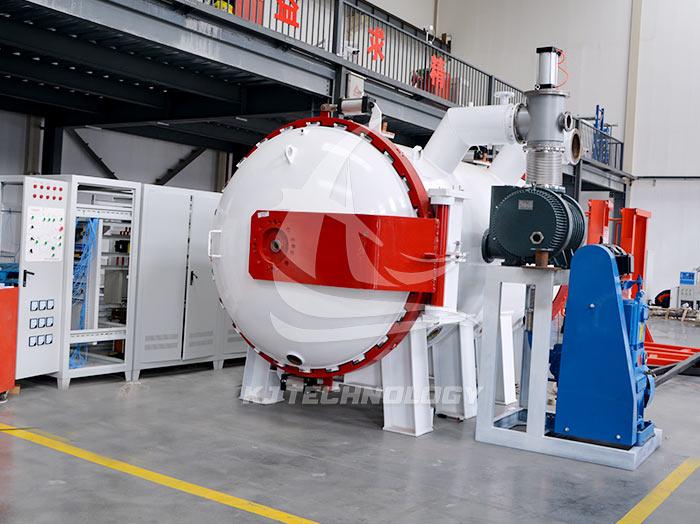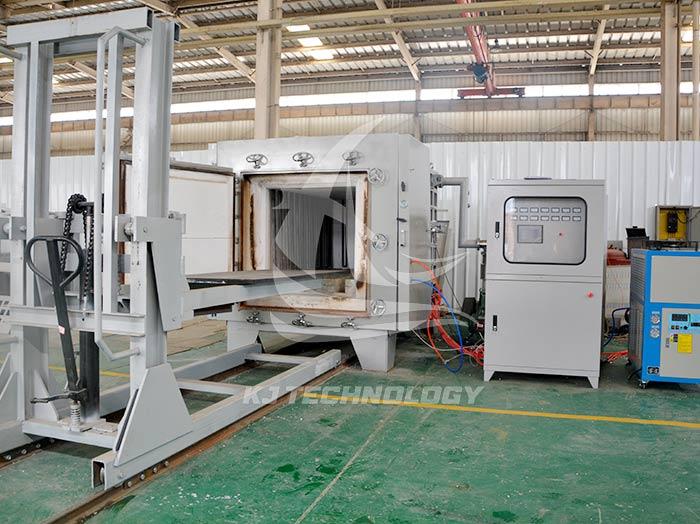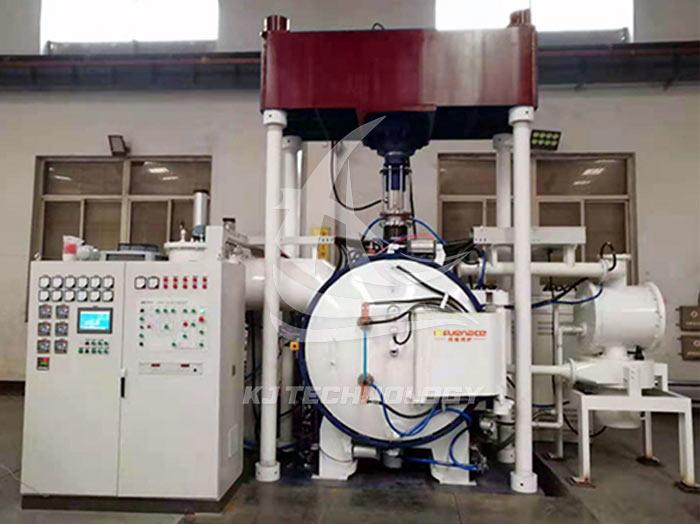Application fields of heat treatment vacuum furnace
 09-10-2025 Author: KJ technology
09-10-2025 Author: KJ technology
Heat treatment vacuum furnaces become the core equipment for high-end material processing by creating oxygen free or low oxygen environments, combined with precise heating and cooling control. Its application fields widely cover industries with extremely high requirements for material properties, surface quality, and process stability. The following are the main application fields and typical cases:
1. Heat treatment of metal materials: improving performance and lifespan
Tool steel and mold steel
Application scenarios: Quenching and tempering of high-speed steel cutting tools, cold work molds (such as stamping molds), and hot work molds (such as die-casting molds).
Advantages: After vacuum quenching, the surface is free of oxygen scale, and the sharpness of the cutting edge is improved; Extend the lifespan of the mold and reduce downtime maintenance costs.
Case: After vacuum quenching, a single set of stamping molds for automotive panels can produce an increased number of parts.
High temperature alloys and titanium alloys
Application scenarios: Heat treatment of aircraft engine turbine blades, gas turbine components, and biomedical titanium alloy implants.
Advantages: Vacuum environment prevents high-temperature oxidation, preserves material surface activity, and ensures subsequent coating adhesion; The toughness of titanium alloy is improved after vacuum annealing, meeting the lightweight requirements of aerospace.
Case: A company uses a vacuum furnace to process LEAP engine turbine blades, increasing the working temperature by 150 ℃ and improving fuel efficiency.
magnetic materials
Application scenarios: Solid solution treatment and aging treatment of neodymium iron boron permanent magnets and soft magnetic alloys.
Advantages: Vacuum environment avoids magnetic powder oxidation, improves coercivity (Hc) and remanence (Br); After vacuum annealing, the magnetic permeability of soft magnetic alloys increases and losses decrease.
Case: After vacuum treatment, the maximum magnetic energy product of neodymium iron boron magnetic steel used in new energy vehicle motors has reached the international advanced level.
2. Semiconductor and Electronics Industry: The Key to Precision Manufacturing
Silicon wafer processing
Application scenarios: Annealing of monocrystalline silicon rods and deoxidation treatment of polycrystalline silicon ingots.
Advantages: Vacuum environment reduces impurity doping and lowers lattice defect density; After annealing, the resistivity uniformity of the silicon wafer is good, meeting the requirements of integrated circuit manufacturing.
Case: A certain chip company adopted vacuum annealing technology to improve the yield rate of 12 inch wafers.
Ceramic packaging and substrate
Application scenarios: Sintering of alumina ceramic substrates and co firing process of aluminum nitride ceramic heat sinks.
Advantages: Vacuum sintering eliminates pores and improves density; After co firing, the bonding strength between the ceramic and metal layers is improved, meeting the heat dissipation requirements of high-power devices.
Case: A certain base station uses ceramic filters to reduce insertion loss and improve out of band suppression through vacuum co firing.
beam welding
Application scenarios: precision welding of vacuum tubes, sensor packaging, and aerospace components.
Advantages: Vacuum environment suppresses arc discharge, welding joints have no pores or cracks; Copper stainless steel dissimilar metal welding has higher strength.
3. Aerospace and Defense: Reliability Assurance in Extreme Environments
Turbine engine components
Application scenarios: Hot isostatic pressing (HIP) and heat treatment of nickel based high-temperature alloy turbine discs and cobalt based alloy guide vanes.
Advantages: Vacuum+high pressure eliminates internal pores of materials, improves fatigue life; The processed components maintain high strength even at 1200 ℃.
Spatial structural components
Application scenarios: Soldering and annealing of satellite brackets and solar panel substrates.
Advantages: Vacuum brazing avoids weld oxidation, and the joint strength is equivalent to that of the base material; After annealing, the thermal expansion coefficient matching of the aluminum alloy substrate is improved, adapting to spatial temperature differences of -180 ℃~150 ℃.
Case: A Mars probe bracket is vacuum brazed, which reduces weight while improving load-bearing capacity.
Nuclear material processing
Application scenarios: Annealing of zirconium alloy cladding tubes, degassing treatment of nuclear fuel elements.
Advantages: The vacuum environment prevents hydrogen induced delayed cracking, and the corrosion resistance of the cladding tube is improved after annealing; The swelling rate of fuel elements decreases after degassing.
Case: A company uses vacuum annealing technology to extend the service life of EPR nuclear reactor cladding tubes.
4. New Energy and Environmental Protection: Promoters of Green Manufacturing
Lithium Ion Battery Materials
Application scenarios: Pre firing and annealing of positive electrode materials (such as NCM, NCA), carbonization treatment of negative electrode materials (such as graphite).
Advantages: Vacuum environment reduces lithium volatilization and improves material capacity retention rate; After vacuum carbonization of graphite negative electrode, the efficiency is higher for the first time and the cycle life is improved.
Case: A certain battery company adopts vacuum annealing technology to increase the specific capacity and energy density of NCM811 positive electrode material.
Hydrogen energy storage and transportation materials
Application scenarios: Activation treatment of hydrogen storage alloys (such as LaNi ₅), annealing of carbon fiber wrapped high-pressure gas cylinder liners.
Advantages: Vacuum activation improves hydrogen storage capacity; After annealing, the stress corrosion resistance of the aluminum alloy liner is improved.
Case: The hydrogen storage tank of a fuel cell vehicle adopts a vacuum annealed inner liner, which has higher working pressure and higher quality hydrogen storage density.
Waste resource utilization
Application scenario: Vacuum distillation recovery of valuable metals (gold, silver, palladium) from electronic waste (such as PCB boards).
Advantages: Vacuum distillation avoids toxic gas emissions and has a higher metal recovery rate; The processing cost is reduced compared to traditional pyrometallurgy.
Case: A certain company adopts vacuum distillation technology to recycle 150 tons of precious metals annually, equivalent to 5% of the global annual production.
5. Medical devices and biomaterials: dual guarantee of safety and performance
Surface treatment of implants
Application scenarios: Vacuum plasma spraying and annealing of titanium alloy artificial joints and cobalt chromium alloy heart stents.
Advantages: Vacuum sprayed hydroxyapatite (HA) coating has higher bonding strength, far higher than atmospheric spraying; After annealing, the coating is dense and crack free, and the biocompatibility is significantly improved.
Case: A certain company's knee joint implant adopts vacuum spraying technology, which reduces the postoperative loosening rate.
Surgical instrument manufacturing
Application scenario: Vacuum quenching and cryogenic treatment of stainless steel surgical knives and forceps.
Advantages: Higher hardness and improved wear resistance after vacuum quenching; Cryogenic treatment (-196 ℃) eliminates residual austenite and ensures dimensional stability.
Case: After vacuum treatment, the service life of a certain surgical instrument has been extended, far exceeding the industry level.
6. Future Trends: Technology Fusion and Emerging Applications
Post processing of additive manufacturing (3D printing)
After vacuum heat treatment, the density and fatigue strength of titanium alloy parts printed by laser selective melting (SLM) are improved.
Nanomaterial synthesis
Graphene and carbon nanotubes are prepared by chemical vapor deposition (CVD) in a vacuum furnace, with layer control accuracy reaching single-layer and low defect density.








